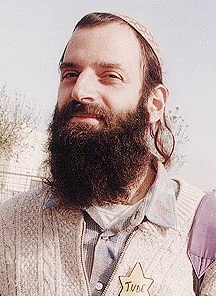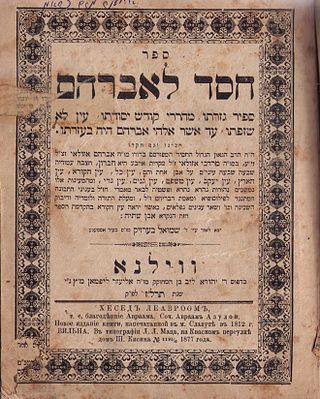
Baruch Kopel Goldstein was an American-Israeli mass murderer, religious extremist, and physician who perpetrated the 1994 Cave of the Patriarchs massacre in Hebron in the Israeli-occupied West Bank, an incident of Jewish terrorism. Goldstein was a supporter of the Kach, a religious Zionist party that the United States, the European Union and other countries designate as a terrorist organization.

Veneration, or veneration of saints, is the act of honoring a saint, a person who has been identified as having a high degree of sanctity or holiness. Angels are shown similar veneration in many religions. Veneration of saints is practiced, formally or informally, by adherents of some branches of all major religions, including Christianity, Judaism, Hinduism, Islam, Buddhism and Jainism.

Ouazzane is a town in northern Morocco, with a population of 59,606 recorded in the 2014 Moroccan census.

Tzadik is a title in Judaism given to people considered righteous, such as biblical figures and later spiritual masters. The root of the word ṣadiq, is ṣ-d-q, which means "justice" or "righteousness". When applied to a righteous woman, the term is inflected as tzadika/tzaddikot.

Haim Yosef David Azulai ben Yitzhak Zerachia, commonly known as the Hida, was a Jerusalem born rabbinical scholar, a noted bibliophile, and a pioneer in the publication of Jewish religious writings.

Israel Abuhatzeira, known as the Baba Sali (1889–1984) was a leading Moroccan Sephardic rabbi and kabbalist who was renowned for his alleged ability to work miracles through his prayers. His burial place in Netivot, Israel has become a shrine for prayers and petitioners.

Ohel is a structure built around a Jewish grave as a sign of prominence of the deceased. Ohelim cover the graves of some Hasidic Rebbes, important rabbis, tzadikim, prominent Jewish community leaders, and biblical figures. Typically a small masonry building, an ohel may include room for visitors to pray, meditate, and light candles in honor of the deceased.

Shalom Shabazi was the son of Yosef ben Avigad, of the family of Mashtā, also commonly known as Abba Sholem Shabazi or Saalem al-Shabazi. He was a Jewish rabbi and poet who lived in 17th century Yemen, often referred to as the arch-poet of Yemen.

Abraham ben Mordecai Azulai was a Kabbalistic author and commentator born in Fez, Morocco. In 1599 he moved to Ottoman Palestine and settled in Hebron.
RebbetzinMenucha Rochel Slonim (1798–1888) was a daughter of the Mitteler Rebbe, the second Rebbe of the Chabad Hasidic dynasty. She is regarded a matriarch to the Chabad dynasty as well as Hebron's Jewish population in general.

The Hebron massacre was the killing of sixty-seven or sixty-nine Jews on 24 August 1929 in Hebron, then part of Mandatory Palestine, by Arabs incited to violence by rumors that Jews were planning to seize control of the Temple Mount in Jerusalem. The event also left scores seriously wounded or maimed. Jewish homes were pillaged and synagogues were ransacked. Some of the 435 Jews in Hebron who survived were hidden by local Arab families, although the extent of this phenomenon is debated. Soon after, all Hebron's Jews were evacuated by the British authorities. Many returned in 1931, but almost all were evacuated at the outbreak of the 1936–39 Arab revolt in Palestine. The massacre formed part of the 1929 Palestine riots, in which a total of 133 Jews and 110 Arabs were killed, the majority of the latter by British police and military, and brought the centuries-old Jewish presence in Hebron to an end.

According to Jewish tradition, the Tomb of Maimonides is located in Tiberias, Israel. Although Maimonides, a Sephardic Jew, died in Fustat, Egypt, on 12 December 1204, it is believed that he was only briefly buried in that city before being reinterred in Tiberias. Owing to his recognition as a prominent Jewish philosopher, his tomb is one of Israel's most important Jewish pilgrimage sites and is also among Tiberias' most visited tourist attractions. The site also serves as the burial place of Yohanan ben Zakkai, a prominent Tannaim of the Second Temple period; and Isaiah Horowitz, a prominent Jewish mystic of the 16th/17th century.
The history of Palestinian rabbis encompasses the Israelites from the Anshi Knesses HaGedola period up until modern times, but most significantly refers to the early Jewish sages who dwelled in the Holy Land and compiled the Mishna and its later commentary, the Jerusalem Talmud. During the Talmudic and later Geonim period, Palestinian rabbis exerted influence over Syria and Egypt, whilst the authorities in Babylonia had held sway over the Jews of Iraq and Iran. While the Jerusalem Talmud was not to become authoritative against the Babylonian Talmud, the liturgy developed by Palestinian rabbis was later destined to form the foundation of the minhag Ashkenaz that was used by nearly all Ashkenazi communities across Europe before Hasidic Judaism.

The old Jewish cemetery in Hebron, is located to the west of the Tomb of Machpela on a hill and has been used as a Jewish cemetery for hundreds of years, as attested to by Ishtori Haparchi, who noted a Jewish cemetery in the area in 1322. Other sources indicate the cemetery being mentioned in a letter dated to 1290.
The Tunisian city of Kairouan, also known as Kirwan or al-Qayrawan was a world center of Talmudic and Halakhic scholarship for at least three generations.
Amram Qorah was the last Chief Rabbi in Yemen, assuming this role in 1934, after the death of Rabbi Yihya al-Abyadh, Resh Methivta, and which role he held for approximately two years. He is the author of the book, Sa'arat Teman, published post-mortem by the author's son, a book that documents the history of the Jews of Yemen and their culture for a little over 250 years, from the Mawza exile to the mass-immigration of Yemenite Jews to Israel in the mid-20th century.
RabbiYosef Haim HaCohen was the President of the Ma’araviim Community in Jerusalem, as well as the rabbi, dayan, shadar and rabad of the congregation.

Shimon Lavi was a Sephardi Hakham, kabbalist, physician, astronomer, and poet. He is credited with the founding of religious institutions and the revival of Torah study in Tripoli, Libya, in the mid-sixteenth century, where he served as spiritual leader and dayan for more than three decades. He authored a commentary on the Zohar titled Ketem Paz and the piyyut, "Bar Yochai", a kabbalistic hymn which became widely popular in the Jewish world. Libyan Jews consider him their greatest scholar.

Second Purim, also called Purim Katan, is a celebratory day uniquely observed by a Jewish community or individual family to commemorate the anniversary of its deliverance from destruction, catastrophe, or an antisemitic ruler or threat. Similar to the observance of the Jewish holiday of Purim, Second Purims were typically commemorated with the reading of The Megillah about the events that led to the salvation, specially-composed prayers, a festive meal, and the giving of charity. In some cases, a fast day was held the day before. Second Purims were established by hundreds of communities in the Jewish diaspora and in the Land of Israel under foreign rule. Most Second Purims are no longer observed.
The Hiloula of Rabbi Isaac Ben Walid is the hiloula, or anniversary of the death of rabbi Isaac Ben Walid. It is one of the most popular hiloulot in North Africa.














